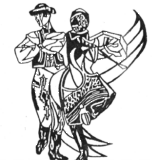

©1995 by: GCU Honorary Editor, Michael Roman K.S.G.G.
The annual New Orleans celebration of Mardi Gras with its merriment, foolery and a carnival atmosphere occurs on Shrove Tuesday. I (the author) have been asked whether the Rusyns had similar celebrations to close their pre-Easter Lenten period. They did not because Great-Lent for the Greek Catholics began on Monday after Cheese-Fare Sunday, according to the Julian calendar. However, they did witness such celebrations in Bardejov and other large towns and villages with several ethnic groups whose Easter Lent as Roman Catholics began on Ash Wednesday, while they were still, in most cases, in the pre-Lenten period.
Fašengy had its origin in the German word "Fasching" which means carnival celebration with excessive merriment. Here is how the Svidnik Rusyn Greek Catholics celebrated the Fašengy in a somewhat toned-down version compared to other ethnic group celebrations in their midst.
The Fašengy or pre-Lenten period began on the day after Epiphany and ended on Cheese-Fare Sunday. A dance for the youthful villagers was held every Sunday evening, ending with a Grand Dance on Cheese-Fare Sunday. I (the author) have noticed that dinner-dances are still held in most parts of the GCU world, thus recalling the Fašengy period of old. According to some historians, "it was natural that more Rusyn marriages occurred in Svidnik during Fašengy than in any other period of the year." According to Reverend Ivan Ladyzinsky, there were at least 30 marriages solemnized during Fašengy.
The married women of Svidnik participated in spinning bees on weekday evenings. The unmarried girls visited a different home for their own spinning bees. The difference between the two visitations was the recent brides and married women met at one pre-arranged home during the entire pre-Lenten period, while the young unmarried girls did not.
The husbands took care of the domestic animals, chickens and geese and kept the home fire burning. The young eligible men, masquerading as ghosts or scarecrows visited the spinners.
The spinning bees of the brides and married women usually ended with a snack and coffee. The spinning women often brought with them some "goodies" and other foods such as milk, eggs and cheese, and the much needed firewood. If they could not do so, they would bring a designated sum of money. As mentioned before, the time and meeting place of the spinners had been agreed to previously. They also had a common fund to buy liquid refreshments to help keep them in good spirits, while spinning tales at the wheel.
When the young men arrived at the home of the spinners they were invited to partake of the food and refreshments. They conversed among themselves while waiting to escort the young women home.
Since the spinning bees were properly regarded as being in the best tradition, they certainly filled a real social need. In some villages the young people would go from house to house singing and dancing, and staying a little longer in the house where there was a daughter or two. Some of the married women frowned upon this custom because they believed such visits would cause crooked feet in chickens and geese.
At the end of Cheese-Fare Sunday, the wives cleanly scoured the pots and pans of any fat and grease as they prepared themselves for a seven week abstinence from meat, milk and other dairy products. The chief meal during Easter Lent was a sour soup called "zavarjanka". It consisted of potatoes and homemade sauerkraut.